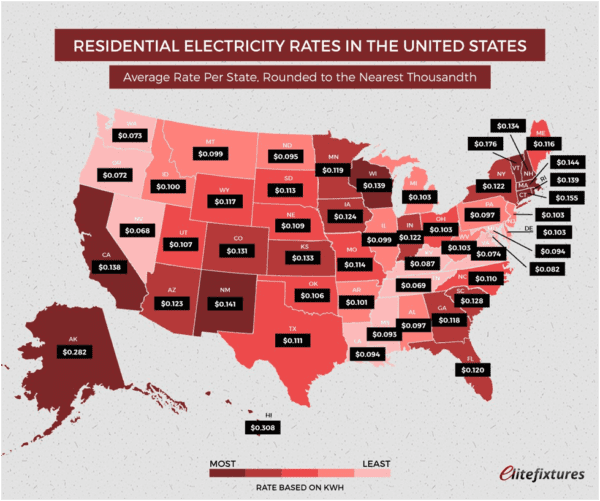Last week, a set of map graphics visualizing average electricity rates by state went viral on Reddit. It amassed over 8700 points and over 1000 comments from users on the site. Beyond just being an interesting topic to discuss, average electricity rates can also be analyzed in relation to where tech hubs are located. Plus, a deeper examination illustrates how significant expenses like these can be for large companies.


These maps above illuminate a large variance across states — and across the top metros for tech. Some of the most expensive states include Hawaii, Alaska, Vermont, and California, one of which obviously contains the famed Silicon Valley. Other rising tech hubs, such as Seattle, Washington DC, San Diego, and Salt Lake City, aren’t all faced with such pricey power. The next question, of course, is the “why” behind the tremendously high rates in states like California.
As it turns out, the reasons for the Golden State’s pricey electricity are no accident. The state has a surplus of generated power because even with decreasing demand for electricity in California, power plants continue to be built. The broad development of solar installations has piled onto the problem. As a result, state government has approved higher rates so that power providers can recoup the building and upkeep costs. This could only add to the high costs for companies in the Silicon Valley and San Diego — which in some cases have caused their jobs to move to less expensive places like Salt Lake City.
The cost of a city can have a huge impact on where companies plant themselves, even simply because employees don’t want to take on higher rent and expenses. Consequently, something as simple as electricity rates can be more significant than one would initially suspect. Not only does it affect company operation costs, but it also affects employee expenses and what they need to be paid (which then, again, impacts the employer’s operation costs).
There have been a vast array of articles predicting the whereabouts of “the next Silicon Valley,” but none seemed to have looked specifically at local utility prices. In this type of forecasting, it may be wise to take factors like cost of electricity into consideration.
 Gearfuse Technology, Science, Culture & More
Gearfuse Technology, Science, Culture & More


